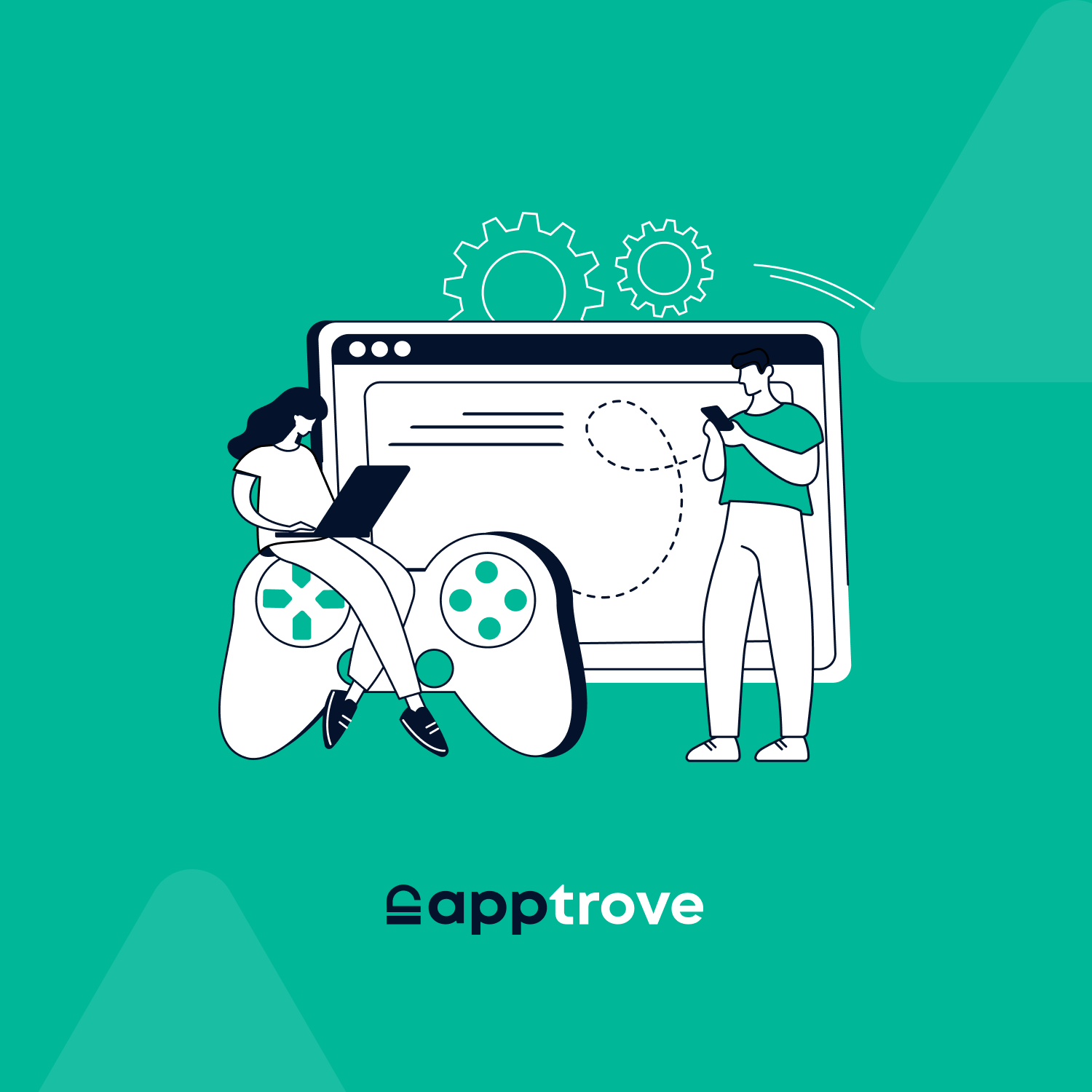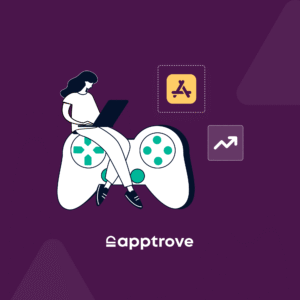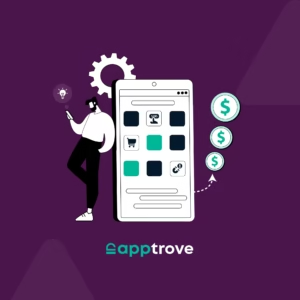Introduction to Idle Games
What if your game kept playing—even when you weren’t?
Idle games allow for that magic to happen, and progress to build while you are out living your life. No frantic tapping, no constant screen time, just intelligent growth and satisfying results, on autopilot.
This guide is for gamers, creators, and marketers who want to know what idle games are and what makes them tick, beyond the buzzwords. If you’re designing an idle RPG game, launching an ad campaign for an idle tycoon game, or simply curious to know why millions of people are addicted to idle miner games, then this guide is for you.
But first, what on earth is an idle game?
Idle games are also referred to as incremental games or clicker games. These are titles where gameplay continues when the player is not actively playing. Tap, collect, upgrade, repeat onwards and upwards as your empire grows in-game, all without the grind. Idle games love to rely on automation, compulsion loops, and smart systems of rewards. The player feels a sense of progress without the rewarding pressure of input.
In this guide, you will discover:
- How the fundamental mechanics of idle games function
- Why players are drawn to them, and what that means for retention
- Genres such as idle RPG games, idle tycoon games, and beyond
- Monetization practices that can grow and expand
- Innovative ideas for marketing and engagement
This isn’t just another generic overview. You’ll get tactical takeaways, real examples, and a sense of the stickiness of idle experiences.
Ready to get started?
Because whether you’re simply a player, or a publisher, idle games are the games that never stop, except when you do.
What Are Idle Games?
So… What are idle games, exactly?
If you’ve ever left a game running in the background and returned to find that your progress has been multiplied—lots more coins, lots more resources, lots more upgrades—you’ve already tapped into the enjoyment of an idle game.
Idle games, which may also be called incremental games or clicker games, are built on a simple but potent game mechanic: you can progress in the game, even when you aren’t actively playing. Idle games are designed to reward players over the long term through automation and transformation, as opposed to fast hands and interaction.
Defining Characteristics of Idle Games
At a high level, idle games are defined by game mechanics that allow for long-term progression with minimal interaction from game players. Here are some of the unique points of idle games:
Passive Progression:
Each game system (e.g., production, fighting/combat, exploration, etc.) continues to play out in the background even when players are offline or inactive.
Upgrade Cycles:
Players use game earnings to purchase upgrades that increase future growth, creating engaging loops of player-based growth and reinvestment.
Minimal Player Emphasis:
Most idle games rely on a minimal level of action, typically just tapping or accumulating and rewarding. Incremental complexity will occur along the way but rarely overwhelm.
Exponential Growth:
Most rewards grow as time progresses creating a compounding return on investment that renders brief episodes feel impactful.
By employing this gameplay loop, participants can engage according to their scores and development, as well as still have the perception of somehow moving forward. It is this balance of lower work and higher reward, that appealed to this emerging genre.
How Idle Games are Different from Active Games:
Unlike most high-paced games—often seen in active forms of gameplay—that demand immediate attention and interaction, idle games allow for more pace and freedom. Players can log in and out of the game whenever. Plus, there is no stress of being behind, only the realization that your progress will be acknowledged even when you are not playing.
Active games call for constant input, in a fast-paced manner, and are often based on quick reflexes. Idle games take it a step further, as they allow players to relax, optimize, and see the results of their increases over time. The distinction is the reaction time—it is more about strategizing over hours and days and compounding investment in all idle gameplay.
Idle Game Genre Brief History:
The idle genre was more or less born in the early 2010s and is well-documented with browser-based gaming and any number of games like Cookie Clicker. Cookie Clicker wasn’t simply a video game; it showed that for over an hour or so, mindless tapping of a button repetitively, as well as upgrading what happened when tapping the button repeatedly, could be addicting and interesting.
Afterwards, the idle genre of video games got better from there and evolved into many better and deeper experiences resulting in many variations of idle gaming such as idle RPG games, idle tycoon games, and of course the sub-genre of idle miner games all of which are essentially the same concept.
The Evolution of Idle Games
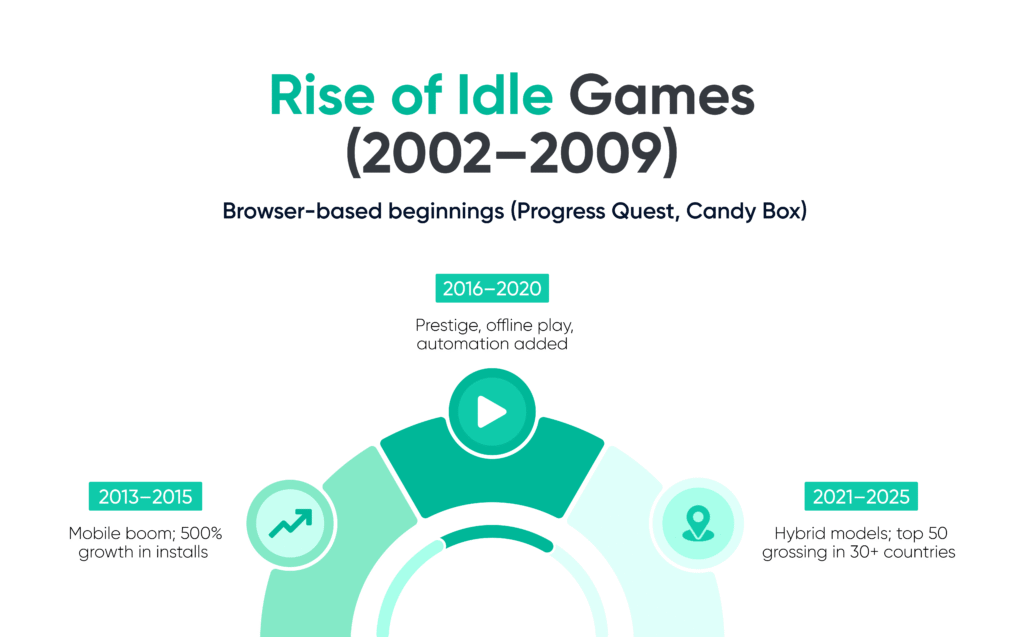
Idle games have come a long way since the early days. This quirky browser-based trend has become a major genre that is inherently using up app stores, altering players’ behaviours. Recognizing how this transition has occurred can help to explain why idle games are more relevant— and profitable— than ever.
From Browser Experiments to Worldwide Phenomenon
The first iterations of idle games emerged as browser games in the early 2010s. Games like Cookie Clicker and Candy Box! allowed a user to engage in simple, repetitive acts of clicking or idling for a number to “grow.” It felt absurd and silly, but these games revealed a player hook that was powerful. That process of upgrading and increasing one’s speed of growth, while exerting minimal input of time/effort is amazing.
For most users, those early browser games answered the question: what are idle games? They provided systems of passive growth where the core mechanic was waiting. Surprisingly, it was tough to put down and walk away from.
The Mobile Revolution
Smartphones led to the next step in idle gameplay. The platform is ideal for this play style, where short mechanics and asynchronous gameplay are the usual norm. Various idle tycoon games and idle RPG games (e.g., Adventure Capitalist, AFK Arena), made use of mobile game features such as notifications, offline progress and ad-monetization, to develop longer lifecycles and better long-term retention.
The idle miner genre is an industry-standard example. The mining resources, upgrading your tools, and automating a workflow loop, is a satisfying gameplay loop that appeals specifically to mobile users.
Advanced Features and Smarter Systems
Idle games now give a longer and deeper gameplay experience. They manage to blend strategy, storytelling, über-layered economies and multiplayer mechanics. Developers are building idle systems combined with an active experience, creating hybrids that integrate depth while maintaining true-to-type engagement.
The idle game genre is not considered niche. It is growing faster than anyone expected, and even redefining how tap gamers can engage with games at scale.
Why Idle Games Are So Popular
The growth of idle games is not merely a fad, but a recognition of how contemporary players want to engage. With everything competing for players’ attention, and our attention spans becoming shorter, idle games offer players a unique balance: the effort required is low while the reward is high.
Unlike action-packed games that encourage players to remain focused and observant, idle games allow players to feel productive without putting in a grind. Idle games encourage players to log in, claim their rewards, upgrade a few things, and then log in. Players can even play for a few minutes at work, sleeping, or while away from the device, and the game keeps ticking on. It’s why idle games are appropriate for the casual gamer, the multitasking gamer, or anyone who wants gaming entertainment without commitment.
The Essence of Simple
At the core of the idle games genre is simplicity. The least complicated idle games relieve the friction of play; there’s no tutorial, no controls to study, and players know exactly what to do with little instruction: tap, upgrade, earn, and repeat. If the player is learning something, the curve is low and players will feel like they are being rewarded.
Feedback loops that keep players hooked
And there’s an even deeper reason for the popularity: psychological feedback loops. Idle mechanics leverage variable rewards, milestone goals, and delayed gratification to engage their players. That means that each incremental action leads to a subsequent action that has the chance to lead to an even bigger payoff later – and that anticipation is addictive.
So, what are idle games at their core?
They are intentionally designed systems to keep players feeling productive, even when that productivity is short-lived. And in a busy, constantly on-world, discovering a sustainable experience like that is not only desirable – it is an addiction.
Types of Idle Games
As the main mechanic, passive progression can be found across all idle games, but the genres of idle games diverge into three different formats. They are characterized by a different theme or type of player motivation – levelling up heroes, building an empire, or getting resources from under the ground. In this section, we will take a look at three of the most common styles of idle games in the market: idle RPG games, idle tycoon games, and the emerging idle miner style of game format.
Idle RPG Games
Idle RPG games add traditional RPG mechanics to the idle space and give players character progression, quests, and loot – without needing to input constantly. Idle RPG games are typically more tailored for the player who enjoys long-term progression and strategy, but may not have the time to manage real-time battles or progression.
Game Mechanics and Progression
In idle RPG games, players form teams of characters or heroes that will automatically battle, but where your focus shifts from playing the game to team composition, upgrade choices, and skill management. Players fight through missions (quests level-up), gain loot, and get experience – even while they are offline. The loop is one of strategy, not button-mashing.
Widely Recognized Categories
AFK Arena, Idle Heroes, and Epic Summoners in turn have led the charge. Formatted like a full digital RPG, but with sensible upgrade options and convenient content that pushes outside of the single-player hours that needn’t be daily.
Crazy Easy
The best idle RPG games give her the balance between not playing every second of combat against meaningful strategic choices. Perhaps not all fights are directly controlled, but players still influence and impact the decision-making when choosing gear, unlocking talents, or optimizing character synergies and when to interact within the idle RPG space. The high impact with limited interaction established the play style that allows the genre to succeed.
Idle Tycoon Games
If RPGs are for fantasy lovers, idle tycoon games are about simulating success in the business world at scale. Thanks to games that take players from running a pizza empire to managing a space station, players can easily automate an entire economy and watch their riches grow.
Business Simulation with a Twist
At their core, idle tycoon games make players virtual CEOs. Players start from a small operation and gradually expand, optimize, and invest. Each level of upgrade allows players to grow faster and unlock new revenue streams. More often than not, the player plays micro-CEO across multiple industries or sites, layering automated systems for supplementary income or to stack systems.
Resource Management and Scaling
Idle tycoon games tend to your core capabilities of scaling: not only are you earning money, but you are reinvesting that money into more staff, server capacity, technology upgrades, and infrastructures. Because this is all presented within an unintimidating framework, players can find themselves completing a refreshable loop of engaging calculations (balancing inputs with optimising outputs) sometimes with prestige, or reset mechanics to extend session length or longevity.
Monetization Designed for Engagement
From a monetization perspective, the structure of idle tycoon games includes a blend of optional ads (to bump rewarded quick increment), premium currencies, in-app purchases, as well as time-skip purchases. Since the core loop provides incremental-based, steady progress, the urge to spend money often feels like a shortcut to not spending time rather than a must-do: making players more people who use the app more inclined to spend with little in-app pressure of needing to spend money.
Idle Miner Games
The idle miner game is one of the most niche types of games, but it has managed to carve out a strong corner of the gaming community by applying idle mechanics to the mining and resource extraction genre. The games themselves simulate and provide an addictive experience of creating digging operations, upgrading equipment, and automating the workforce, which matches perfectly with audiences looking for progress through efficiency.
Automation and Depth
In a typical idle miner game, players manage a series of mines, each with unique resources and production rates. They upgrade elevators and transport systems based on production. They also unlock automation devices to smooth out the workflow, which becomes necessary as the mine gets deeper.
Upgrades and Progress Offline
One of the most appealing pull factors of idle play and the idle miner game format is the upgrade structure – players are not just upping the values for income, they are upgrading processes, managing bottlenecks, and unlocking tiers of production. As well, friends will get progress offline – so when they jump back into the game after a break, their mind is still “running”, and is generating an income to be reinvested when the player returns to the game.
Examples of Titles and Why They Work
Idle Miner Tycoon, Deep Town and Mining Inc. all showcase just how compelling this niche can be. Players can see visually that their mining network grows from small to massive because of the way the idle miner game produces proceeds based on both the player’s direct input and the automated processes that the player has created. All of this meets well with the user who loves automating all the processes.
What sets Attack of the Idle Miner apart from many other distractions is its gratifying visual feedback, trellis of strategic decisions, and relaxation-based, non-linear progression. This game is about optimizing systems—not racing against the clock, which is exactly why players keep digging back in.
Game Mechanics and Features
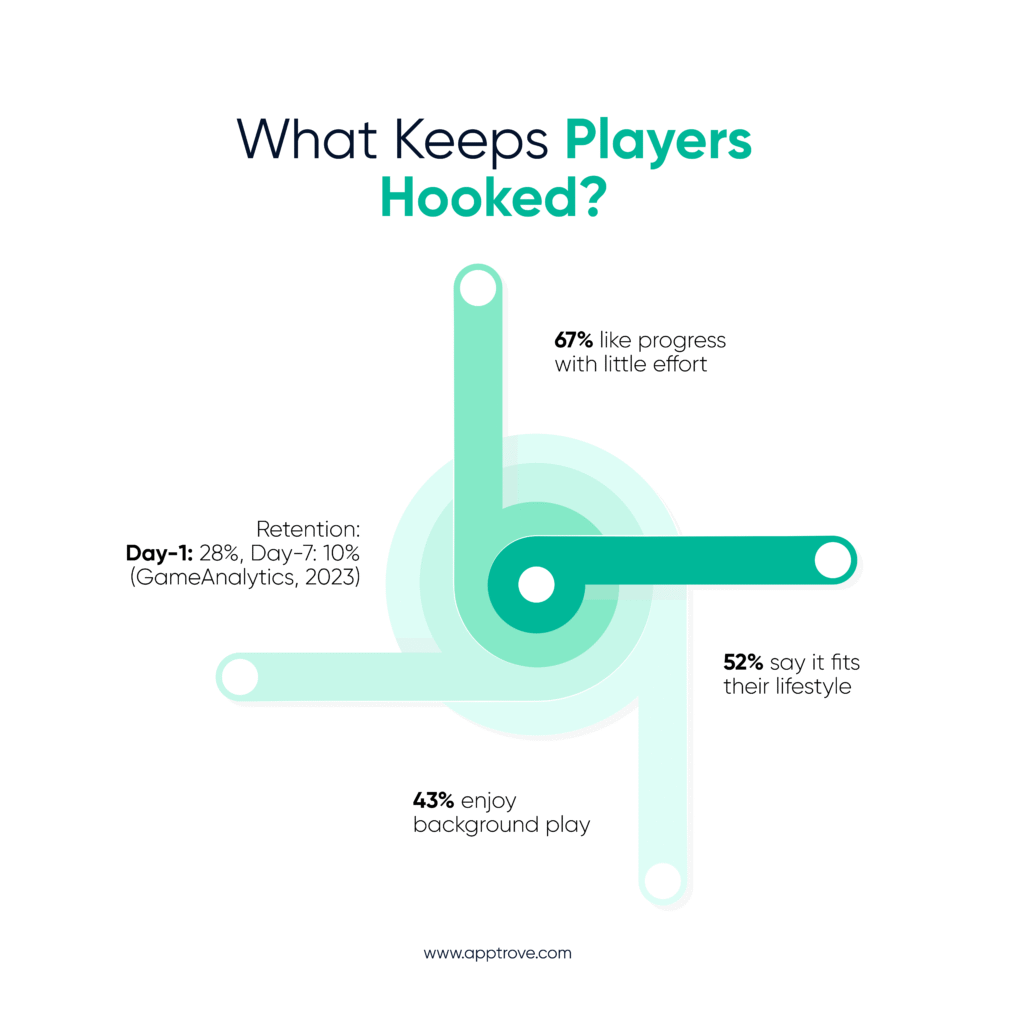
There is more to idle games than their simplicity; the mechanics are well thought out and designed. Many may have a simple interface, but idle games are implemented using sophisticated systems that produce ongoing progression and commitment without keeping the player active. Idle mechanics can range from simple clicking tasks to fully automated economies, the systems that drive idle games are both elegant and incredibly addicting.
Core gameplay loops
Every idle start with a rather simple loop: perform an action, get rewarded, and invest for accelerated future rewards. Many of those actions are essentially a click, where players can tap, or complete simple actions, for currency, or experience in the game. Those actions activate the growth curve and give the player immediate feedback.
As the idle game unfolds, the manual actions system is replaced- or complemented- with passive systems. What started as an active loop, is now a passive loop, which defines idle games. Manual inputs become optional, and the player attention shifts from completing actions to optimizing systems.
This transition is what makes idle RPG games, idle tycoon games, and other sub-genres so engaging – as the gameplay loop develops and continues to change, the player’s role transitions from executor to strategist, which keeps the gaming experience new throughout increasingly long play sessions, which allows for the game to be sustained over time.
Progression Systems
One of the most unique features of idle games is their long-term progression systems. Progression systems in idle games include things like prestige, rebirth, or ascension, where you reset your current progress for permanent upgrades or multipliers. This mechanics exists in both idle RPG games and idle tycoon games where somewhere in the game when you reach that ceiling on earning or efficiency, the option to reset becomes available. The advantage of resetting creates that feeling of exponentially earning more progress in the next run while giving the player the feeling of fulfilment in what they’ve already accomplished.
With these reset mechanics, idle games also typically have incremental boosts, such as skill points or passive bonuses, and timing limited events, which create numerous layers of progression for players to strive for and work together inside the one gameplay loop. This provides players with clear objectives and meaningful goals to progress towards without becoming overwhelmingly complex and, provides that deep sense of incremental accomplishment that is at the core of idle games through one sustained gameplay loop.
This progression structure helps to provide a greater substance to the idle game experience while taking low effort, who doesn’t love that, high reward pathway?
Automation & Offline Gains
An essential feature of idle games is the ability for players to continue accruing progress even while they are not online to engage fully. Through a range of automated systems – auto-collecting workers, passive income, and timed events – players can accumulate resources consistently.
For example, in an idle miner game, the automated systems of the game are effectively able to mine whole mounds of resources whenever the player is away. As such, upon their return, they have a pretty large vision commitment, and plenty of resources to continue reinvesting in, as they collect.
Offline gains create a potent reward loop:
players are always rewarded for coming back, but they are never punished for taking a break. This feature is a fundamental fact as to why idle games are both successful and ever-evolving.
Popular Idle Games in 2025
In 2025, idle games are still going strong on mobile and web, offering some simplicity, depth, and meaningful progression. Whether you prefer fantasy combat, business tycoon sim, or digging/resource extraction games, there is an idle game experience that will fit your style.
Idle RPG Games
In the world of idle RPG games, AFK Journey stands tall, providing auto-battling and beautiful graphics, character upgrades, and an evolving storyline. Players construct teams with strategic intent and accumulate enough heroes – several which can be unlocked while the auto-battling occurs in the background. Clicker Heroes has aged better than expected with its minimal/clean design and addictive upgrade loop; always draws in new players and old!
Idle Tycoon Games
In terms of idle tycoon games, Egg, Inc. is the leader with a clean interface and layers of gameplay mechanics to explore from research development to delivery fleet optimization. It is easy to begin playing and becomes increasingly satisfying as you master it! Adventure Capitalism also continues to be commonly played and recognized widely. The game is fast-paced empire-building, serves some humorous themes, and has a very clear monetization path that feels fair and optional.
Idle Miner Games
The idle miner category of games continues to be hot. Idle Miner Tycoon is at the top with its structured mining system, automation mechanics, and a large number of offline progress features. Players will advance through numerous different mines, with unique obstacles and upgrade choices along the way. Mr. Mine Idle is a new take on idle mining since it merges mining mechanics with exploration themes and underground areas to progress through.
Future Title to Lookout For
A title definitely on the rise in 2025 is Grow a Garden, an idle game that features farming themes, where you automate your crop upgrades and experience cooperative multiplayer elements. This is a new take on idle games and is a great example of how idle mechanics can move into a more social and creative space.
Idle games are one of the most functional and usable genres on the market today. There is nothing to not love about the potential for casual daily play to long-term optimizations.
Mobile Idle Games & APK Mods
With the rapid rise of idle games on mobile platforms, many players have started exploring unofficial versions known as mod APKs. These modified files promise enhanced gameplay, faster progress, and access to premium features—but they also raise important questions about safety, fairness, and legality. Here’s what you need to know.
What Is an Idle Games Mod APK?
A modified APK of an idle game refers to a modified version of a mobile idle game that has been altered from its original programming and code to unlock different aspects and/or features of the game. These include highly sought-after items including infinite in-game currency, premium items already unlocked, a faster time to ‘level-up’, or removal of advertisements.
Instead of going through the official version in the app store, players must download and manually install the mod APK through any number of third-party websites. They may sound tempting due to the maximum upgrades available or instant access to the next tier of the game, and it must be noted they come unsupported or recommended by the developer of the game.
Many people obtain modified APKs specifically for reasons such as skipping the grind associated with the type of idle RPG game, speeding up the production rate in an idle tycoon game, or removing the wait time in an idle miner game. A modified APK often leads to a completely different game experience which can feel much faster and sometimes imbalanced as compared to the original version.
The plus side to playing modified APKs is that it is an instant satisfaction. The downside would be the lack of safety and overall satisfaction in the long run. It is important to understand both conflicting outcomes before you decide to play a modified version of any idle game.
Are Modded Idle Games Safe?
The most prominent concern for any idle games mod APK is security and safety. Since mod APK files are distributed outside of certified platforms like Google Play Store or the App Store, they are not subject to the same verification for security through the credentials of the original developer. This means a mod APK could be anything, including malware, spyware, or other malicious code.
Downloading a mod APK of a popular idle game may include basic software that may compromise your device, collect sensitive data, or even gain unauthorized access to your account. Additionally, some modded APKs could even require users to accept risky permissions that they may not readily see.
And then, there is the issue of stability and functionality. Since modded versions are developed independently, it’s common for modded games to crash, fail to function as expected, or become “incompatible” after an update. And of course, there is the risk of being banned or having your progress erased by servers if the game itself detects your use of a mod APK.
The temptation of being able to advance through the game quicker, or being able to access those VIP features that typically cost money is certainly appealing, however, it’s worth your time to consider the consequences carefully. If you are truly concerned with security and the longevity of your gaming experience, it will likely be safer for you to stick with downloading original idle games.
Popular Idle Games with Mod APKs
The idle game mod APKs that are downloaded the most frequently tend to be modified versions of popular games with active player bases. The idle RPG games are perhaps the most well documented, with modified versions of AFK Arena and Idle Heroes, commonly referred to as “mod” where you get to do free hero summons, unlimited gems, or unlock all the “VIP” levels for free.
In the space of idle tycoon games, modified APKs of both AdVenture Capitalist or Egg, Inc., and other titles would promise unlimited money and the ability to not watch ads, appealing to players who simply do not want to bother grinding.
For idle miners, the common idle miner game, Idle Miner Tycoon, is notorious for having modified versions in APK libraries, promising enhanced automation, unlocked mines, and faster resource collection.
Even though these excitement-creating games can provide development benefits in the short term, they change the progression curve, detract from achieving in-game accomplishments, and can change the overall balance. For the majority of players, to play idle as anticipated, gaining satisfaction from real-time progression in an official idle game provides the best possible long-term experience.
Idle Games and Battery Life: Low Impact, High Reward
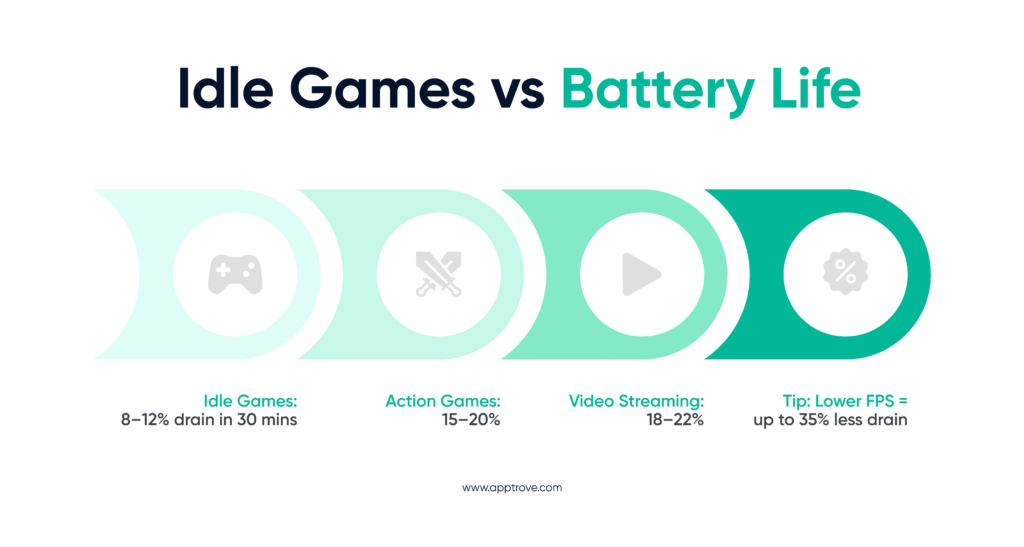
One of the lesser mentioned benefits of idle games, especially on mobile, is that they drastically help battery life. Instead of playing more demanding games like action titles or streaming apps, idle games consume so much less power while still providing the player with meaningful progress and satisfaction.
Usage comparisons suggest that idle games result in an 8-12% battery drain after 30 minutes of play, while action games can account for a 15-20% drain, and apps like video streaming typically consume 18-22% of battery in the same time frame. This is significant because players can play longer on the many idle RPG games, idle tycoon games or a simple idle miner game without worrying about a charger.
Why is it important? It matters because battery life is a major friction point for mobile players. If users feel they can progress through a game without sacrificing the longevity of their phone, they are more likely to return frequently—and will stay longer.
The efficiency of idle games is not isolated to gameplay loops. Because of their visual simplicity, real-time animations are more limited, and frame rates are lower, idle games consume less system resources. Even better, idle apps can greatly increase this efficiency by decreasing FPS settings which may lead to up to a whopping 35% less battery drain!
Future Trends in Idle Gaming
As technology progresses, idle games are set to adapt in exciting and unpredictable ways. Developers are going to explore possibilities now that advanced technology such as AI, blockchain, and even virtual reality can be integrated, and they can bring deeper engagement and expanded gameplay options.
AI is being implemented to enhance personalization, find ways to respond to players and suggest upgrades; save time by optimizing idle loops; or even manage game difficulty on the fly. There’s a clear potential for a new layer of strategic complexity and depth, particularly in idle RPG games and idle tycoon games as they evolve to become smarter, and learning from player activity rather than being merely passive play experiences.
Blockchain is gaining popularity, especially about ownership and reward systems. Some upcoming idle games are using crypto-based economies where players can earn or trade digital assets. The idea that players can earn something of value in a game that did not previously require time or money (passive play), is very interesting and could evolve idle games into something with real-world value.
Virtual reality is also an exciting opportunity to develop this genre. Instead of visualizing your idle miner game, imagine a fully immersive 3D environment, where you are managing their operation in a real-time space—for instance, being able to oversee the production, delegate tasks, or watch as your idle mining operation expands before your eyes. There is still a lot of development, exploration, and innovation needed before this happens, but this could transform the way players engage with idle mechanics.
Development is on a path toward creating idle games that will be more interactive, personalized, and immersive as a player. However, all of this will still be incorporated with the existing value that idle games provide for all gamers, which is little effort associated with a high-reward experience through progression.
Final Thoughts
From basic clickers to advanced strategy hybrids, idle games have shown themselves to be one of the most flexible and rewarding genres to play. Whether it be the layered complexity of idle RPG games, the empire-building of idle tycoon games, or the sheer efficiency of an idle miner game, there is more than enough in this genre for everyone.
During the genre’s stage in evolution, using today’s rapidly growing technology and creative design now is the correct moment to find out what idle games have to offer. Jump in, try styles, and enjoy your progress, at your pace, on your schedule.
